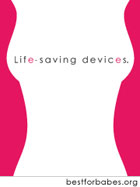Trying to find the right bra while you're pregnant may seem impossible. Not only are your breasts changing size and shape regularly, but at times they can be sore—making you feel like wearing no bra at all!
While you can simply buy a larger bra during pregnancy, most OB-GYNs and midwives recommend wearing a nursing bra instead. Your breasts will likely go through various cup sizes, especially during your last trimester and after childbirth. If you nurse, your breasts will be larger as your milk supply changes to meet your newborn's needs, and your breast size should stabilize as you and your baby get into a regular feeding schedule. Fortunately, nursing bras can be adjusted to accommodate changing cup and band sizes of pregnancy and nursing.
How are nursing bras different from regular bras?
Nursing bras are made for comfort and accessibility - but they don't have to be unfeminine or ugly. Today's bra manufacturers understand that women want the same kind of appeal with their nursing bras that they do with their pre-pregnancy intimate apparel.
Like regular bras, nursing bras have adjustable hook-and-eye clasps in the back of the band. Whereas regular bras may only have one to three hooks to alter the band size, nursing bras usually have four, often with the hooks two-deep (top and bottom) for added support. Most nursing bra bands are also wider to lift milk-laden breasts.
Cup support is where nursing bras most differ from regular bras. To make breasts accessible, nursing bras offer several options. A popular design has clasps at the top of the cup fabric that you fold down for feedings. Other nursing bras have snaps between the breasts so you can fold the fabric flap toward your armpit. Another design allows you to move the fabric around the breast, propping it forward. It is important to find a clasp that's easy to undo one-handed since you'll often be holding your hungry baby while getting ready to breastfeed.
Cotton is often the fabric of choice for nursing bras because it dries quickly (important for keeping nipples dry when nursing). The jury is still out on synthetic materials. Some say these fabrics don't breathe as well as cotton, whereas other experts indicate that some newer bras have specially designed synthetic fabrics that breathe as well if not better than cotton. Your best bet: word of mouth. Ask around and find out what other moms have found success with.
Additionally, various styles may work better at different times in your pregnancy and nursing experiences. You may want the added support of top clasps during the early weeks of nursing when you may also be wearing nursing pads. Then, once you and your baby become nursing pros, claspless designs may work better for your lifestyle.
How do you find the right fit with a nursing bra?
Finding the right fit for your nursing bra is important. "If a nursing mom is wearing a brassiere that is too small, it will lay on top of the breast tissue," explains Beatriz Cacheux, a bra-fitting specialist with Medela, Inc. "This will put added pressure and strain on the tissue, which may lead to plugged milk ducts." To avoid an ill-fitting garment, take some measurements to make sure that you have the right size. "Eighty-percent of women are wearing the wrong size bra," adds Cacheux.
To find the proper measurements, start by wearing a non-padded, well-fitting bra, prompts Anne Dimond, founder and president of Bella Materna, which produces nursing bras. "Wrap the measuring tape snugly around your rib cage, just under the bustline. Be sure the measuring tape is parallel to the floor from front to back." This measurement - for instance 36 or 38 inches - is your band size. If you measure between sizes, round down for a snug fight and up for a more relaxed fit.
To find your cup measurement, bring the measuring tape around the fullest part of your breast. Cacheux cautions women not to wrap the tape tightly but rather position it loosely over the breast. Subtract the number of this second measurement from the band size and then check manufacturer's websites or brochures for the corresponding cup size (all makers are different). For example, if the measurement around your breasts is 41 inches and your band size 38 inches, the difference would be three inches. According to Medela's specs, this would make your bra size a 38C.
If you're trying bras on, look for a comfort level that offers the right balance for you. If the bra is too loose, your breasts won't be supported, but if it's too snug you'll be uncomfortable. Keep in mind that when you begin nursing your breasts will be larger and you may need to use nursing pads. Rounding up a band size can accommodate these changes.
More bra manufacturers are now recognizing the needs of larger-breasted women. For example, Materna's bra sizes go up to E/F but soon G/H cup sizes will also be available. The Bravado brand offers nursing bras in sizes up to 46H - a real plus for full-figured moms. Ask your local maternity-wear retailer or look online if you are concerned that you won't be able to find your cup size.
Can I order my nursing bra online?
"Women are becoming more and more comfortable ordering their undergarments online," says Dimond. She recommends that women check the sizing charts to find the right size. If possible, have yourself professionally measured. Contact the manufacturer and seek clarification about their sizing and recommendation before purchasing bras online since most retailers do not accept exchange or return since these are considered to be personal hygiene products.
How do I wear a nursing bra correctly?
Once you have the perfect bra it's time to ensure the right fit. Dimond advises you put on your bra while bending over slightly, lifting the breasts into the cups. Glide each breast into the cup when you stand.
Have someone else adjust the straps in the back so they fit snugly to your skin. "Check your nipple alignment," continues Dimond, "adjusting to make both centered." If you find that you need more room in your band size, hook-and-eye band extenders are readily available in most maternity boutiques and online.
What's the best way to wash my bra?
A little extra care can extend the life of your bra and ensure that it doesn't lose its elasticity and shape. Simply handwash your bra in a mild detergent in the sink and leave it to dry overnight. In the morning your bra will be clean and ready to wear. Some women find this a great time-saving tip: Wear your bra in the shower and wash with your favorite-scented shower gel. Then let the bra hang in the shower overnight. If you must use your washer, make sure to choose the cold setting, a mild detergent, and hang dry afterwards. Never put nursing bras in the dryer.
Are underwire bras safe during pregnancy and nursing?
"Underwire bras can be of a concern during nursing," says Christina Holmes a practicing midwife and director of Birthways in Sarasota, Florida. Tight-fitting underwire bras can push into breast tissue, leading to clogged milk ducts. She explains that although most underwire bras are usually safe (if they are good-quality bras), cheaply made non-nursing bras are sometimes made with sheet metal and can be highly irritating (ouch!). Holmes adds that if a woman knows that she's prone to breast infections she should consider another kind of bra. Some manufacturers, such as Bravado, offer non-underwire bras specifically for women who need the extra support and lift an underwire provides. If you're confused or have questions, talk to your OB-GYN or nurse midwife.
Ready to start shopping? Nursing bras come in numerous styles to fit even the most finicky of tastes. Take time to look at a variety of bras to find one that meets your needs - and your baby's.
Friday, May 4, 2012
How to find the right bra during pregnancy - and beyond!
Labels:
bra,
Cami Sutra Cami,
camisole,
comfort,
Glorious,
medela,
melinda g,
seamless underwire,
sleep,
softcup seamless softcup,
Sports Bra,
T-shirt Underwire,
Tee Shirt Soft Cup,
underwire
Subscribe to:
Post Comments (Atom)



























No comments:
Post a Comment